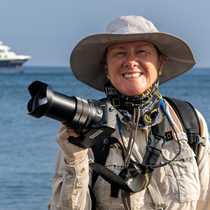We have arrived to the easternmost island, and one of the oldest islands, in the Galapagos Archipelago. Chatham in English, we spent the morning exploring the easternmost point of the easternmost island, Punta Pitt. This was named for William Pitt the Elder, who sponsored expeditions to the new world in the mid-1700s and was also the 1st Earl of Chatham. Most the islands started with English names, placed by English-speaking pirates and privateers, the first to draw charts of the area starting in the late 1600s.
Dry, exotic terrane; highly eroded and sculpted by time, wind and water (though rarely by this last factor). It is a dramatic land, the first sight had by the members of the H.M.S. Beagle expedition in 1835.
The trail leads up a dry ravine bed, steep for 320 feet. Then it plateaus towards the outer coast, where the cool breeze refreshes. The wildlife was fabulous! For the first time in a long time, the blue-footed boobies are looking successful in their nesting…nests with eggs, nests with little new hatchlings, nests with big fluffy chicks. Red-footed boobies also looked successful, as we saw them in the trees and bushes, adults incubating, as well as bigger chicks covered in downy feathers.
What thrilled me to no end were the sightings of newly hatched marine iguanas. This island was one of the first to be inhabited by humans, and therefore also one of the first to have had the domestic cat introduced into its ecologically naïve ecosystem. A couple hundred years later, feral cats are a major problem for the national park service; difficult to control, difficult to even find. This eastern portion of Chatham Island has several important species that are highly endangered precisely because of these feline predators. So, to see these small iguanas making their way in starts and dashes from several hundred meters inland where they hatched, to the outer coast - where food and better shelter can be found - was a thrill.
Young global explorers received classes in how to drive a Zodiac landing craft - a necessary (and fun) skill, very helpful especially if one's future plans include becoming a competent Lindblad Expeditions naturalist!
But the water in the afternoon off Cerro Brujo beach was the icing on the cake. Not only for our younger travelers, but for everyone - a last chance to bathe in the Pacific waters of Galapagos; an ocean with sea lions, sharks, turtles, penguins, cormorants, and hundreds of fish species and marine invertebrates; where the inhabitants are protected from the ravaging ways of humans; where lives are lived as they have been for millennia. A last chance to decompress before re-entry into the modern human world of cities, buildings, cars and airplanes.
How fortunate we have been.







